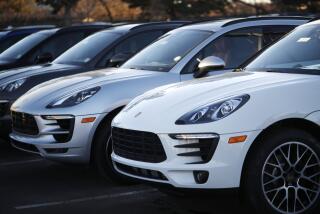Looking at the Beetle’s Early Years With a New Perspective
- Share via
Karl Ludvigsen offers an exhaustively detailed history of the origins of the Volkswagen Beetle, the role the enormous factory built to produce it played during World War II and the postwar maneuvering that finally led to commercial production of the popular car.
As its name implies, the Volkswagen was designed to be the people’s car. To fulfill his plan to put the German middle class in private cars on the newly constructed autobahns, Adolf Hitler intended to manufacture the VW--designed by Ferdinand Porsche--in such volume and at such a low price that manufacturers in Germany, America and Europe saw it as a major economic threat.
From the outset, the VW received a generally favorable response. It wasn’t luxurious or especially attractive, but it was what people in Europe wanted and needed: a car that was practical, economical to run and easy to repair.
German workers could buy Volkswagens through a plan that resembled a Christmas Club account. Each week, participants deposited 5 marks in return for a stamp in a savings book. When the total reached 750 marks, the saver was to get a specific number on the list of cars allocated to his district. (The claims of thousands of prewar savers dragged through the courts for decades after the war.)
These savings programs (which eventually totaled 275 million marks), plus the funds from the Nazi seizure of the German Labor Bank, provided the capital needed to build a gargantuan plant near the village of Fallersleben in Lower Saxony. The factory, which stretched nearly four-fifths of a mile along the Mittelland Canal, was designed to produce as many as 1 million autos a year.
World War II derailed those plans. The early Beetle was modified into a military vehicle that could carry soldiers over rough terrain, from the deserts of North Africa to the frozen steppes of Russia. There was even an amphibious model, the Schwimmwagen.
As the conflict progressed, the output of the VW plant switched to war materials, and the upper levels of the factory became a target for Allied bombs.
After the war, the partially damaged plant, its remaining equipment and the patents Porsche held on various innovations spent years in legal limbo. The occupying forces and private companies in Allied countries all cast covetous eyes on the potential value of the plant and its output.
Plans, schemes, offers and counteroffers circulated, including dismantling the plant for reparations and takeover by a major European or American manufacturer. Britain, the administrator of the region surrounding Fallersleben, eventually negotiated an agreement, and the VW Beetle went into production.
*
Ludvigsen clearly loves the Beetle, Ferdinand Porsche and the Fallersleben plant. These affections slant his account, sometimes oddly. He complains that after the war, the French detained “the apolitical Porsche.” Apolitical? Porsche met with Hitler and other high Nazi officials, used SS officers to test-drive the prototype VWs, and was involved in the manufacture of bombs and airplane parts for the Luftwaffe, including the V-1 buzz bomb--which Ludvigsen describes as “the most exotic product to grace the Fallersleben factory during the war.”
Even stranger is Ludvigsen’s tendency to discuss the plant as if it were a living entity with thoughts and feelings: “Still wounded, still struggling to find the supplies it needed to build cars, still listed as available for dismantlement for war reparations--the great works was an object of both pride and pity a decade after its architects had been commissioned.”
And: “No favors were done to the plant by the forced laborers who realized in April 1945 that the war was over for them. Many detainees ran amok. In their vengeance they smashed and wrecked indiscriminately.”
A more balanced observer might express less concern for the “struggles” of a factory and more sympathy for the prisoners of war who had been used as slave labor, in violation of the Geneva Convention.
This enormously detailed history will undoubtedly provide a useful reference for historians of automobiles and auto manufacturers for decades to come, but much of it makes for very strange reading, indeed.
*
Charles Solomon can be reached at highway1@latimes.com.






